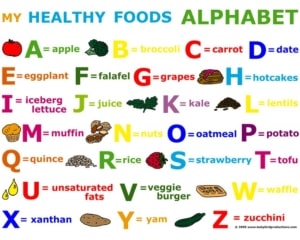Weekly Intervention Ideas: February 22nd Edition
Theme: Nutrition and Mental Health
Theme: Nutrition and Mental Health
Alphabet Food Game: Engaging with kids and teens about the various types of food groups can be helpful in raising their awareness around different ways of nourishment as they grow. The category mindfulness game is a fun and engaging activity to introduce and talk about food to try, add to their plate, and be curious about!

Sample Progress Note: The focus of the session was (tailor based on treatment plan). The therapist engaged the client in an activity naming various food groups to support building healthy nutrition habits. The client responded to the activity by (fill in the blank).
Gottman Relationship Recipes: The Gottman Institute, one of the leading organizations for couples therapy, has developed “relationship recipes” to help couples improve their communication skills, strengthen their feelings of connectedness, and promote feelings of calmness during tense times. “Ingredients” for these recipes include different skills and strategies couples can implement into their lives. To learn more about the “Seven Principles Dip,” “Self-Soothie Smoothie,” and “Softened Start-Up Conflict Crostini,” visit :https://www.gottman.com/blog/gottman-relationship-recipes/
Sample Progress Note: The focus of this session was… The therapist helped the couple explore ways to incorporate Gottman couples therapy skills and activities into their daily lives. The couple was (engaged/receptive/disengaged/etc) while exploring this topic, and they (were able/struggled/somewhat able) to identify ways of incorporating couples therapy skills and activities in their daily lives.
Intuitive Eating: Intuitive eating is one way for people to heal their relationships with food and their bodies. It involves becoming attuned to the body’s natural hunger and fullness cues, honoring the body for what it can do (not how it looks), developing trust in oneself, and neutralizing foods so that there are not “good” foods and “bad” foods. To learn more, read about the 10 Principles of Intuitive Eating: https://www.intuitiveeating.org/10-principles-of-intuitive-eating/
Sample Progress Note: The focus of this session was… The therapist helped the client explore their relationships with their body and food, as well as provided psychoeducation about intuitive eating. The client reported that exploring their relationships with their body and food was (helpful/not helpful/painful/etc), and the client expressed that they are (likely/not likely) to begin finding ways to incorporate intuitive eating into their life (e.g., [list examples]).
Mindful eating: Incorporating mindfulness with eating can foster a different, sometimes positive, experience surrounding food and mealtimes. Mindful eating can cultivate appreciation for one’s five senses through food, enjoyment with meals, intentionality for what one is eating, greater ease of digestion, and even reduced distress around food/meals. This can be done in session or given as an activity to do in between sessions with themselves and/or with another!
Sample Progress Note: The focus of this session was… The therapist led Ct. in a mindful eating meditation to build awareness around healthy eating patterns. Ct. (engaged/did not engage in the activity), and they reported that the mindfulness meditation as (helpful/difficult/not helpful)
• Holding: First, take a raisin and hold it in the palm of your hand or between your finger and thumb.
• Seeing: Take time to really focus on it; gaze at the raisin with care and full attention—imagine that you’ve just dropped in from Mars and have never seen an object like this before in your life. Let your eyes explore every part of it, examining the highlights where the light shines, the darker hollows, the folds and ridges, and any asymmetries or unique features.
• Touching: Turn the raisin over between your fingers, exploring its texture. Maybe do this with your eyes closed if that enhances your sense of touch.
• Smelling: Hold the raisin beneath your nose. With each inhalation, take in any smell, aroma, or fragrance that may arise. As you do this, notice anything interesting that may be happening in your mouth or stomach.
• Placing: Now slowly bring the raisin up to your lips, noticing how your hand and arm know exactly how and where to position it. Gently place the raisin in your mouth; without chewing, noticing how it gets into your mouth in the first place. Spend a few moments focusing on the sensations of having it in your mouth, exploring it with your tongue.
• Tasting: When you are ready, prepare to chew the raisin, noticing how and where it needs to be for chewing. Then, very consciously, take one or two bites into it and notice what happens in the aftermath, experiencing any waves of taste that emanate from it as you continue chewing. Without swallowing yet, notice the bare sensations of taste and texture in your mouth and how these may change over time, moment by moment. Also pay attention to any changes in the object itself.
• Swallow and Enjoy!
• Source: Raisin Meditation | Practice | Greater Good in Action (berkeley.edu)
Our wellness experts will be happy to take care of you. You can CLICK HERE to schedule an appointment now or call (612)223-8898.
We’re united by our commitment to providing effective, relevant, and innovative mental health support at all stages of your journey. Click Here to find out more about who we are, where we come from, and how we live out CARE’s mission every day.
The professionals at CARE are actively collecting and creating resources to help with what you need. We’re Here for You.